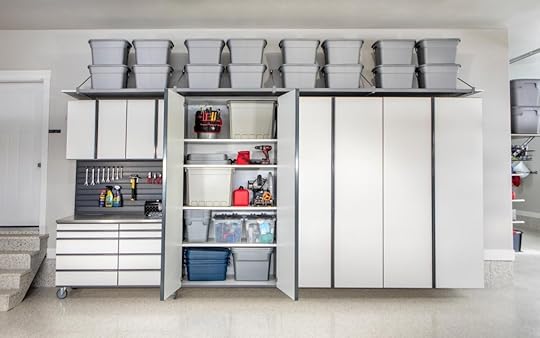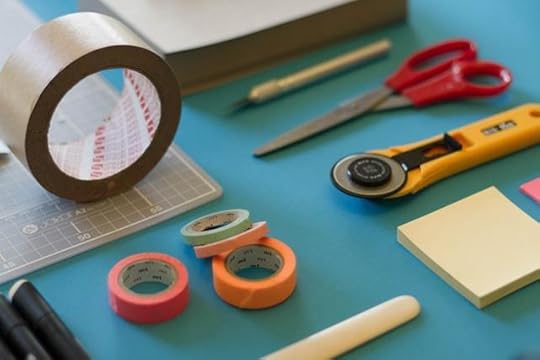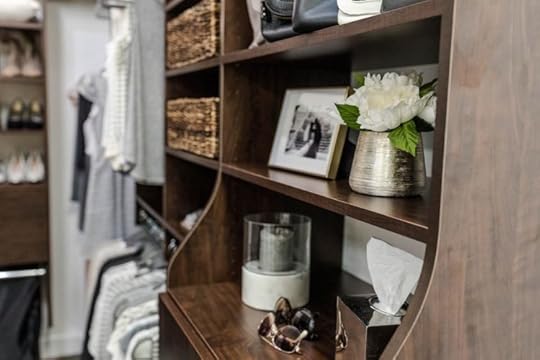Donna Smallin Kuper's Blog: The One-Minute Organizer Blog, page 3
May 19, 2020
Why You Should Get Ready for Your Next Move Now

While some people will remain in the same home for decades, the average American relocates about a dozen times in a lifetime. And more than one out 10 of Americans move every year.
Moving can be a strenuous, stressful process, especially if you’re living with an overabundance of stuff. Decluttering your home now will streamline your next move. Even if you have no immediate plans to move, pretending that you do is a very effective strategy for decluttering your home. Following are some tips for getting started.
Reduce clutter daily
When the time comes to start packing boxes and to actively prepare for a pending relocation, dealing with excessive clutter can dramatically increase your stress level.
On a daily basis, spend some time decluttering.
Remove items from your home that you have not used in the last year or two and
that you do not plan to use soon. This includes clothing and shoes, sporting
equipment, books, video games, small appliances and more. Ask yourself if an
item is worth the time and effort to pack and unpack as well as the additional
expense to move.
In addition, avoid bringing new things into your
home that will not be used regularly. Remember that you can rent or borrow some
items rather than purchasing them. The less you need to move, the less you’ll
need to pay to move it, whether you’re renting a truck or hiring professional
movers.
Get – and stay – organized
In addition to reducing clutter in the home,
focus on organizing your belongings. When the items in your closets or other
storage areas are neatly contained in labeled bins or other units, packing and
unpacking during a move is significantly easier to do.
You can also take advantage of organization
features in the pantry, drawers, garage and other areas to keep your belongings
neat, organized and ready to load into the moving truck when the time arrives
to do so.
In keeping your home organized, neat, and free from clutter, an unanticipated move will go much smoother.
Clean more frequently
An essential part of the move-out process
involves cleaning your home. This is true whether you rent or own your current
space.
So, in addition to weekly chores like vacuuming
and dusting, add deep cleaning chores to your monthly to-do list. This may
include cleaning the baseboards, wiping down the inside of your cabinets and
pantry, cleaning the fridge and more.
Decluttering your home, keeping it organized and clean will make it much quicker and easier to prepare for your next relocation. And you’ll be in a much better position to dive into the actual process of moving.
And when you’re ready to make your next move…
The first step is to create a realistic budget – especially if you’re moving long distance. This will include costs for movers or a truck rental, boxes and other supplies, deposits, insurance and more. Investigate your options. Get multiple bids.
Make your arrangements as soon as possible so that you can properly pack and be ready to move on a specific date. Now is the time to make hard decisions about what to keep and what to sell or donate. It makes sense to remove items from your possession that will not be needed in your new space rather than pay to haul them to your new space. Factors like storage space in the new home, the dimension of rooms and more must be taken into consideration.
Gather essential supplies. If you regularly keep your belongings organized in labeled storage bins and other similar containers, you may be able to save money on moving supplies. However, you’ll still need to purchase some boxes, tape, protective material and other supplies. It’s much faster and easier to pack for your move if you have all of your supplies on hand. Remember to protect all of your belongings as you place them in boxes.
Bottom line: Whether you know you’re moving in
the near future or simply want to reduce the hassle of your next move, start
preparing now. It’s never too early to begin preparing for an easier
relocation.
Austin Winder is a public relations specialist, living in
Memphis, TN. He graduated with a business and marketing degree from the
University of Memphis.
The post Why You Should Get Ready for Your Next Move Now appeared first on Declutter Your Life with Donna Smallin Kuper.
May 7, 2020
How to Improve Your Life by Cutting Clutter
We all know that cutting clutter from our homes frees up space and give us a great sense of accomplishment. Plus having a more organized home make it easier to find what you want when you need it. It’s also easier to clean and that’s super important, especially right now, because a cleaner home is a healthier home.

Change your environment, change your life
The benefits of cutting clutter go even deeper than you might realize. When you’re surrounded by only the things you love and use, your home becomes your happy place. Instead of chaos, there’s calm. You feel it, and your family and guests feel it too.
Decluttering has the potential to be life-changing. As you sort through your stuff, you become more mindful of what’s really important to today, not yesterday or tomorrow. That can be very eye-opening! You may realize that you don’t need more stuff and start investing the money you save. You may find that having less stuff to manage means you have more time to do things you’ve always wanted to do.
There’s no question that clutter can mess with your emotional, spiritual and physical well-being. Less stuff to manage means less stress, something doctors say is important for a healthier lifestyle. The graphic below reveals how clutter can mess with your health and provides a few simple ways to decrease clutter throughout your home.
Thoughts? Comments?
Graphic created by Closet Works.
Main photo (top) by Aarón Blanco Tejedor on Unsplash
The post How to Improve Your Life by Cutting Clutter appeared first on Declutter Your Life with Donna Smallin Kuper.
April 17, 2020
How to Spring Clean Your Garage in 5 Steps
 Photo courtesy Platinum Garage Solutions
Photo courtesy Platinum Garage SolutionsSummer is coming, and so will the desire to have an organized garage. You won’t want to maneuver around cluttered boxes when you’re getting ready for the first BBQ of the season.
Clutter is stressful, making “organize the garage” the last thing you want to do, but a clean garage can create a healthier and happier lifestyle. Just like a burnt dinner, some things just need a fresh start. Here’s how to spring clean your garage in five steps.
Step 1: Remove Everything
First things first, remove everything in your garage. Put all of your items in the driveway, working in phases if you don’t want to take everything out at once. Clearing the garage will make it easier for you to see your space and make it easier to organize when you get to that step.
When all of your shelves are cleared, you’re ready to start sorting your belongings. Don’t be surprised if you find that you have more than one of the same item! It happens.
Step 2: Separate Items into Categories
The soccer ball you stored for your child
should not be in the same box as your electric saw. For obvious reasons. As you
move items from your garage to your driveway, separate them into categories
that make sense. Consider the following common categories:
SportsAutoLawn and GardenToolsSeasonal
Your categories may look different depending
on your hobbies and interests.
Next, decide what you want to keep and what
needs to go. Do you really need that pool floaty that popped last summer? No.
Throw it away. Identify which items need to be tossed out or recycled and the
things that can be donated or sold. (Hint: If you haven’t used it in the last
year, it’s probably time to say your sweet goodbyes.)
Also say goodbye to anything that’s unfixable and items you no longer have a use for in your current lifestyle. Once you’ve decided on the items you need (or want) to keep, we can get to the fun part – cleaning and organizing.
Step 3: Give Your Garage a Good Cleaning
Now that your garage is cleared out, it might be a good idea to clear out those cobwebs. To clean the garage, start from top to bottom. Dust the top of cabinets and shelves, wipe down walls with a wet cloth or mop, and then sweep and mop the floor. Maybe even give it a fresh coat of paint. After the garage is clean, you can get to my personal favorite part of spring cleaning your garage – organizing.
Step 4: Create Zones
Create zones in the garage for the categories you made in Step 2. Where do you want to keep your snow skis versus your weed killer? This is entirely up to you. It’s your garage, so you get to decide where to place all of your belongings. Once you’ve decided what will work best for you and your family, put the items into the appropriate zones.
Step 5: Maximize Your Storage Space
Cabinets are a great way to maximize your garage storage space. With
everything behind closed doors, your garage will have the clean, finished look
you’ve always wanted. If you
decide to purchase garage cabinets, look for sturdy shelves that won’t bow
under the weight of your items and that will withstand regular daily use. A
durable cabinet solution is well worth the investment.
Need a little more inspiration? Here are seven ways to eliminate garage clutter.
###
Megan Kezell is from Platinum Garage Solutions, a garage enhancement business in Omaha. When she isn’t writing about organization, she can be found exploring the great outdoors or spending time with friends.
The post How to Spring Clean Your Garage in 5 Steps appeared first on Declutter Your Life with Donna Smallin Kuper.
April 13, 2020
An App for Cleaning House?
If you’re like most people, you’re cleaning house more often these days. Although technically a chore, cleaning house can be quite therapeutic. I find that cleaning helps to reduce stress, especially when you have your favorite music playing. Plus, the act of cleaning house gives a sense of accomplishment. Bottom line: In making your house look better, you also feel better.
That said, I can think of a lot other things I’d rather be doing than cleaning the toilet or wiping spatters from the bathroom mirror for the umpteenth time. With more family members at home right now, you may be finding the need to clean more often than usual. I’m also hearing from a lot of people who are having a hard time getting motivated to clean.
And then, voila! I received an email from this company with a list of “Household Cleaning Apps” that I didn’t know existed. Maybe one of them will help you get or remain motivated and focused on cleaning. And who knows? Maybe introducing younger family members to a cleaning app will turn out to be a simple way of teaching them this important life skill.
Just so you know, I haven’t tried any of the apps mentioned below, but I find that apps can be surprisingly helpful which is why I’m sharing these cleaning apps with you. If you decide to download one, I’d love to hear what you think! (You may need to enlarge the graphic below to read it.)

The post An App for Cleaning House? appeared first on Declutter Your Life with Donna Smallin Kuper.
April 2, 2020
How to Organize Any Workspace
 Photo by Jo Szczepanska on Unsplash
Photo by Jo Szczepanska on Unsplash Working in our homes is the reality for many whether it be with our hobbies or legitimate businesses. You may have developed your own routine of doing things. But it can still be hard to get projects done quickly and efficiently if you are working in a cluttered space.
With an overabundance of supplies and work materials, you may find yourself wasting time trying to find certain items. Or maybe you find yourself getting distracted when trying to work around the clutter. This can have an effect on how quickly you can complete tasks and on the quality of your work, too.
To make sure you’re producing your best work, whether professionally or leisurely, you may want to try some of the tips below to help you organize any workspace.
Declutter
Decluttering your workspace is important to do before you start organizing your space. If you skip the first step, decluttering, clutter tends to return quickly after you organize your space. Decluttering essentially rids your workspace of unnecessary and rarely used items.
Start by sorting your belongings into groups like everyday necessities, less frequently used, and no longer (or never!) used or needed. Of course, you can create your own groups. The important thing is to remove items that are just taking up valuable space and getting in the way of your creativity and productivity.
Increase Storage
Storage space is a critical component to organize any workspace. If you have a home office for your job, you may find it helpful to find office furniture that comes with an ample amount of storage. Desks with plenty of drawers, bookcases, and shelving units can help with storing your office supplies while still complementing the design and style of your space. While a hobby or craft space may be set up a little differently, storage is still important for the abundance of differently sized items.
“Organization is key, especially when you are a crafter! In order to be the most efficient in your crafting tasks, I recommend keeping your supplies in clear storage containers . This will not only allow you to stay organized, but you will be able to see exactly where everything is, as it is safely stored.” – Samantha Broas, Digital Designer at Michaels
As a crafter, Samantha knows first hand that storage, and specifically clear containers, can be essential when trying to organize your space. When using these containers, try to separate your supplies by type. For example, keep all fabric in one container, trimmings in one, and spools of thread in another. You can keep the containers in your general workspace or tucked away in a closet. Wherever they are, you’ll still be able to see what’s inside without having to open each container and sort through every time.
Pegboard Wall
While they are commonly forgotten about as an organization tool in a workspace, pegboards can be the perfect solution for keeping everyday supplies up and out of the way and easily accessible for use. They can be installed above your desk or work station for all your tools and supplies.
In a craft space, hooks and bars that attach to the pegboard are perfect for holding your rotary mats, scissors, or even baskets of paints. If you’re setting up your pegboard in a home office, it is equally as beneficial. Many people will create their own configuration of hooks, bars and baskets on the board to hold everything from office supplies to decor pieces. That’s what makes it so great! You can completely customize your board to organize any workspace.
Work Station Organizers
Work station and desk organization is key in any work area as well. Investing in desk shelving trays will help to keep your small, frequently used items out of the way. Most desk organizers will come with several compartments or drawers to make room for a range of different supplies. In a typical home office, this can be great for pens, pencils, paper clips, or push pins. In a crafting or hobby space, they can also be used for smaller sewing needles, T pins, cutting tools, or art supplies like beads and rhinestones. Desk organization is arguably one of the most important ways to organize any workspace. That’s because having a clean and clear space to work will increase the efficiency of your work. .
Install Shelving
Utilizing your vertical wall space is important in any workspace as well. This will help with eliminating clutter in your main work area and repositioning your supplies out of the way. You can use shelves above or around your workstation to organize books, papers, and even decor pieces. To keep your area efficient, place some of your everyday items on the lower shelves that are within easy reach. Leave higher shelves for your decor or rarely used items. Lower shelves are a great place to store some of those clear storage containers as well.
Organizing your work or hobby space doesn’t have to take an immense amount of effort, time, and skill. You can start with some of these quick tips and then let your space guide you. Think about the storage and organizing options that migh work best for your work area and comment below with some of your own ideas!
The post How to Organize Any Workspace appeared first on Declutter Your Life with Donna Smallin Kuper.
February 27, 2020
Closet Cleanout: How to Part with Clothes
 Photo by Charisse Kenion on Unsplash
Photo by Charisse Kenion on UnsplashWe all have those pieces in our closet that we rarely (if ever) wear, but just can’t seem to let go of. Whether it’s a dress you wore for a special occasion or a favorite pair of jeans that no longer fit, it can be difficult to say goodbye. Here are four closet cleanout strategies for how to part with clothes, especially those-hard-to-let go-of pieces in your closet.
Follow the one-year rule
If you haven’t worn a particular piece of clothing in a year, then it’s time to let it go. A one-year period is a good time frame because it accounts for all holidays and seasons, ensuring that you’ve had the opportunity to wear seasonal or special occasion pieces. The same rule should be applied to clothing that needs to be mended or repaired. If the item is not patched or stitched up in a year, chances are it never will be.
To help you keep track of what you wear throughout the year, turn your hangers so they face the opposite direction. Whenever you wear a piece of clothing, hang it back up with the hanger facing the right way. At the end of the year, you’ll be able to easily see which pieces you haven’t worn.
You may be thinking, “I have space in my closet, so why can’t I keep all of my clothing?” Just because you have the physical space doesn’t mean you have to fill it. Only keep in your everyday closet what you love and wear.
Try everything on
Chances are you have clothing in your closet that no longer fits. As you go through your closet, try everything on. Don’t hold on to something if you don’t like the way it looks, feels or fits.
You don’t have to get rid of every single piece of clothing that no longer fits. But keep in mind that clothing styles and your personal taste in clothing changes every year. So when you get back to that size you’re holding on to, you’ll most likely want new stuff anyway.
Store out-of-season and keepsake clothing elsewhere
A simple space-saving strategy is to store in your everyday closet only clothing that’s in season. Store out-of-season clothing in a guest room closet or elsewhere. It that’s not possible, move out-of-season clothing to one end or both ends of your clothing rod, leaving the more accessible center space for in-season clothing.
As you go through your closet, you may find there are items you don’t wear, but that have sentimental value. It may be difficult right now to let go of keepsake items such as your wedding dress or other clothing mementos. That’s fine, but these pieces shouldn’t reside in your everyday closet. Try to limit the items to your favorite pieces that are in good condition and have a strong sentimental value.
Before storing any clothing, be sure to wash and thoroughly dry items, or have them dry cleaned. Next, wrap keepsake clothing in acid-free tissue paper and store in acid-free storage boxes or plastic lidded bins made of polypropylene. Clearly label each box and store in a climate-controlled area, such as under your bed. Avoid storing in a basement, attic or garage, or in plastic bags as they can trap moisture and cause mildew.
Use a closet cleanout service
Decluttering your closet can be an exhausting, yet rewarding process. If you decide to donate to your favorite charity, know that someone, somewhere will be so happy to have the items that were just taking up valuable space in your closet.
If you’d like to try selling clothes, but don’t have the time to do all of the work that goes into selling them, consider bringing them at your local consignment store. Or look into a closet cleanout service such as thredUP. An online consignment shop, they do all the work for you, including photographing, listing and selling. And when your items sell, they send you a check – or you can opt to receive store credit. To sell your clothes online, simply fill a cleanout bag with your gently used items and send it to them.
By the way, I wrote about thredUP in my book How to Declutter and Make Money Now. The Kindle edition is free February 27-March 2, 2020. Note that since publishing this book 5 1/2 years ago, some of the web links are broken. But there’s still lots of good information in there for cleaning out your closet – and your entire home.
Oh, and once you get your closet cleaned out, here are some ideas for maximizing your closet space.
The post Closet Cleanout: How to Part with Clothes appeared first on Declutter Your Life with Donna Smallin Kuper.
February 10, 2020
Top 7 Tips for Your Cluttered Closet
 Photo courtesy of More Space Place
Photo courtesy of More Space PlaceIf you’re like many people (even fairly organized people), your closet may be one of the most cluttered spaces in your home. Maybe all you need to do is schedule some time to get after it. Or maybe you have no idea how to whip your cluttered closet into shape.
The key to decluttering your closet is to remove items you no longer love or use and then implement solutions to maximize every inch of storage space. Here are 7 tips for dealing with cluttered closets that will help you declutter your closet once and for all.
Mount a Second Clothing Rod
One easy and inexpensive way to create more storage space is to add a second clothing rod below the first one. This makes better use of the space you have for hanging clothes. Consider hanging tops on the top rod and bottoms on the bottom rod.
Another idea is simply moving the current rod you have to be slightly higher in your closet. This creates more room for drawers and other storage options that will make it easier to optimize your closet space. In a child’s closet, you might want to try both ideas. Use the higher rod to hang less frequently used items and set the lower rod to your child’s height so that he or she can more easily remove and rehang items.
Add Wall Hooks
One closet storage solution that’s often overlooked is to utilize wall space. Add hooks to hang items such as hats and purses or even tote bags that you can use to store lightweight things like bathing suits or scarves and gloves. You can purchase individual hooks or wall racks with multiple hooks for storing a variety of items. There are even hooks designed to hang cowboy hats!
Hooks are a great place to hang items that you access frequently such as your bath robe or a favorite jacket. And they free up valuable real estate in your closet for other items. This helps to keep your closet organized and makes it easier to navigate.
Use the Back of the Door
In addition to using wall space as storage space, you may be able to use the back of your closet door for storage. The most commonly used solution is a shoe bag or shoe rack that hangs over the top of the door. A shoe bag with clear storage pockets is a great solution for shoes, but can also be used to store belts and scarves – even socks and underwear!
You can use adhesive hooks or an over-the-door rack with multiple hooks for hanging individual items for easy access. The back of the door may also be the perfect place to store purses with a special purse organizer.
Create Corner Storage
Your closet may offer corner storage at the back for bulky items or items you use less frequently such as special occasion shoes. By purchasing a small corner storage cabinet you’ll be able to clear up some shelf space without having to spend a fortune. Here’s one on Amazon. Look for inexpensive options at your favorite big box store such as Walmart or Home Depot.
Move a Dresser into Your Closet
Once you make some space in your closet, you may find that you have room for a small dresser or chest of drawers. There’s a reason why professional closet organizers recommend drawer storage. It keeps all of your clothing in one place – and gives your closet a neater, more streamlined look.
If you have a small dresser, try moving it into your closet. If not (or if yours is too large), measure your space and look for a dresser that will give you some additional storage space. You may find something at a local thrift store that is perfect as is, or just needs a little bit of sanding and some paint or stain.
Add Shelves Up Top
Most standard wall closets are built with one clothes rod and one shelf above that. Adding shelves above the existing shelf makes excellent use of all that wasted storage space that extends up to the ceiling. The new shelf space can be used to store items that don’t require frequent access such as out-of-season clothing and long-term document storage.
Adding shelving may also help declutter your floor space, which is often wasted by bulky luggage. These can be a major contributor to unwanted clutter in your closet space. Freeing up some much-needed floor space opens up the possibility of adding other storage solutions as well.
Hire A Closet Design Professional
If you’re finding your current closet system to be less than desirable, consider contacting a custom closet designer who can help to create a system that works for you. Take the time to do your research to find a closet designer who knows how to work with your space, no matter how big or small this space may be. Read reviews from customers and ask for a complimentary consultation.
Like these cluttered-closet-no-more tips? Let us know what you think and leave some feedback, including your own closet storage tips!
Spencer Andrews is a content specialist who specializes in interior design content. In his free time, he enjoys playing lacrosse and spending time outdoors.
FULL DISCLOSURE: This blog may get a small commission for referrals to some of the links on this page (specifically the links to Amazon products). Many thanks for following up on these recommendations.
The post Top 7 Tips for Your Cluttered Closet appeared first on Declutter Your Life with Donna Smallin Kuper.
January 28, 2020
6 Ways It Pays to Get Organized
It’s hard to get organized or lose weight or do anything for that matter unless you’re motivated. What if I told you that you could save hundreds of dollars a year by getting organized? Would that motivate you? Heck, what if you could actually make money by getting organized? Yes, it pays to get organized!
 Photo by Joshua Hoehne on Unsplash
Photo by Joshua Hoehne on Unsplash Never Again Pay a Late Fee.
Have you ever had to pay a late fee on a bill because you misplaced it? Join the club. Nearly a quarter of adults say they pay late fees because they can’t find the bills.
The solution? Set up a simple bill paying system. As bills arrive, file them in a folder labeled “Bills to Pay.” If you get paperless statements, mark the due dates for each on your calendar. Or schedule to pay upcoming bills every time you get paid.
Use Gift Cards Before They Expire.
Have you ever discovered that your gift cards have expired before you’ve had a chance to use them? Almost $1 billion in gift card value wasn’t spent in 2015, according to the latest data from the market research firm CEB. And some (not all) major credit card gift cards are charged a monthly fee if not used within a set time – a fee that eats into your balance until there’s nothing left!
The solution is to use gift cards right away. Don’t put them in a drawer where you’re likely to forget about them. Keep them in your wallet, so they’re handy for purchases. If you don’t think you’ll use them, sell or trade them for gift cards you will use.
Plan Ahead and Eat Out Less.
Do you often eat out or order in because you don’t have ingredients on hand to make dinner? It pays to get organized. Schedule time each week to plan meals and create a shopping list for the ingredients you need. Then rotate your family’s favorite meals to cut down on your weekly planning time.
Another smart way to save time and money is to make large batches that you can portion out and freeze for future meals. And don’t let food go to waste. If you have fresh ingredients that need to be used up, search for recipes using those ingredients at a recipe site like All Recipes. And be sure you’re storing your food properly.
Don’t Pay to Store Your Stuff.
Are you paying for storage of items that you aren’t using? According to AARP, Americans will fork over $37.5 billion this year on storage, at an average cost of about $90 a month.
Add up how much you’re spending each month for off-site storage. Is it worth it? Imagine being able to put that money into your savings each month. Plus, if you decide to let it go of your storage unit, you can make some cash immediately by having a “storage shed” sale or selling items online.
Cancel Unused Subscriptions & Memberships.
Do you subscribe to magazines that aren’t getting read? Most people can keep up with no more than three subscriptions a month. If you aren’t regularly reading the ones you currently receive, cancel your subscription – did you know that you can get a refund for the unused portion?
What other subscriptions or memberships are you not using? Most are renewed automatically. If you’re not ready to cancel just yet, change the auto-renewal to a manual renewal so you can make that decision when the time comes.
Buy and Sell in the Secondhand Market.
I remember reading the results of an eBay survey stating that the average American household has $3,000 of re-saleable items in their home. Many people think it’s too hard to sell items so they continue to hold on to them as their value continues to go down.
It’s actually quite easy to sell items online through Craigslist or through one of the smartphone apps like OfferUp or LetGo. All you need to do is set up an account, take photos of the items, describe them, and post them to find interested buyers in your local market. If you have gently used clothing purchased in the last 2-4 years, take it to a consignment shop or sell on Poshmark.
In addition to selling, consider buying from the secondhand market. I often find very high-quality items in excellent condition for a fraction of the original retail price. Seven years ago, we had an estate sale and put the money into a savings account. I vowed then and there that when we decide to trade our full-time travel life for a bricks-and-sticks home someday, I will not deplete my savings to buy new furnishings. I’ll scour my local secondhand market. Like my parents used to say, money doesn’t grow on trees!
Yes, indeed. It pays to get organized. What’s been your experience?
Full disclosure: This blog may get a small commission for referrals to some of the links on this page (specifically the link to Gift Granny). Many thanks for following up on these recommendations.
The post 6 Ways It Pays to Get Organized appeared first on Declutter Your Life with Donna Smallin Kuper.
January 12, 2020
Clean Off Your Desk
She’s got paper clutter, he’s got paper clutter, we’ve all got paper clutter! Did you know that today is National Clean Off Your Desk Day?
 photo credit: administration YRI_8459 via photopin (license)
photo credit: administration YRI_8459 via photopin (license) If you’ve got piles of paper on your desk (or your kitchen counter or table), maybe what you need is a paper decluttering plan. Here are some of my best strategies for clearing away paper clutter.
My favorite strategy
Box it up. Clean off your desktop or kitchen counter by gathering and putting all your papers in a box for temporary storage. As you do that, toss anything that is clearly trash such as expired coupons and flyers for events that already took place. Meanwhile, if you are looking for something, you’ll know it’s in the box.
Set aside 15 minutes. Plan to spend 15 minutes daily to go through papers in your box. The best way to work it into your schedule is to do it right after something you always do like clean up after dinner or brush your teeth. Set a timer and get to it.
Question everything. When deciding what you need to save, ask yourself, “Do I need to save this for legal or tax reasons?” If the answer is yes, file it. No? Then ask yourself, “Could I get this information again pretty easily if I needed it?” If so, let it go.
What about junk mail and magazines?
Clip and save. Rather than keeping entire magazines for selected articles, clip and save just the articles and file them in binders by category; for example, home decorating ideas or recipes. Insert the articles into 3-hole-punched plastic sheet protectors. Use dividers to create subsections. Consider unsubscribing to magazines you don’t have time to read. Did you know that you can request a refund for the unused portion of your subscriptions?
Dump the junk. If you have piles of unopened junk mail offers, credit card solicitations, and catalogs, dump them. Don’t even give it a second thought because more of the same is already on its way to you! Request to get off these lists at www.dmachoice.org.
Shred when necessary. Be sure to shred pre-approved credit card offers and any papers with personally identifiable information such as account numbers to reduce the risk of identity theft.
Keep paper clutter at bay
Set up a simple filing system. I’ve tested a lot of filing systems over the years and this ready-made system is my favorite. It’s actually set up to be self-purging with email reminders about what to do at the end of each year. See how Freedom Filer makes it easy to file and retrieve your important papers from today forward. (Look for the Ready-Made Systems.)
Keep up with today’s stuff. Designate a basket for collecting incoming mail until you have a chance to look at it. Sort through mail daily or weekly and either toss or file. Opt for paperless statements from your bank and other financial institutions and from your phone and utility companies and let them do the filing for you!
How will you celebrate National Clean Off Your Desk Day? What is your favorite paper decluttering strategy? Do tell! Leave your comments below.
The post Clean Off Your Desk appeared first on Declutter Your Life with Donna Smallin Kuper.
January 7, 2020
5 Ways to Simplify Your Finances

If you’re like many people, organizing your finances is one of those tasks you keep putting off. But the rewards for doing so – saving time and money – are well worth the effort. Even better, simplifying your finances will simplify your life.
The best way to start? Schedule
time to review and simplify your bill-paying process. Whether you want to
reduce expenses as you head into the new year or pad your savings account, try
putting the tips below into practice.
Go Paperless
Going digital will
eliminate paper clutter and may even save you some money. Most financial
institutions will store your statements and transaction receipts for free for up to five years. And some billers offer discounts for setting up automatic digital
payments.
Choosing the digital route will also save you time. Sifting through file cabinets jam-packed with financial statements, bills, and receipts can be very frustrating and time-consuming. Managing your accounts online allows you to have a one-stop shop for all of your files. And it gives you instant access for any information you need from anywhere.
Evaluate Payments
Evaluating your payments
goes beyond simply keeping track of how much you’re spending. It’s a good idea
to review your monthly expenses annually.
Research all of the financial options that could help you streamline your expenses in the long run. For example, if you’ve been thinking about refinancing your mortgage loan, now might be the perfect time to do so while mortgage interest rates are low.
Or, take a closer look at
any other monthly payments you make. From cutting the cord on your cable
provider to lowering your cell phone data plan, there are many ways you can
lessen your payments and simplify your finances.
Take Out Cash
While carrying cash might
feel like a thing of the past, it may benefit you more than you think. If
you’re someone who tends to go over your budget, paying for everyday expenses
with cash could solve the problem.
Limiting yourself to the cash you have in your wallet will help you keep better track of the more regular, smaller, payments you make each day. Try using cash for your daily or weekly purchases like coffee and groceries. You may find that your smaller expenses add up to be more than expected, giving you the opportunity to revamp your personal budget.
Consolidate Accounts
From multiple insurance
providers to streaming subscriptions, it’s safe to say it’s not possible to
have one account for everything. However, there may be ways you can consolidate
your accounts, resulting in savings of time and money.
The perfect way to
simplify your finances is by lessening the number of companies you’re sending
payments to each month. If your homeowner’s insurance and car insurance are
provided by two different agents, look into bundling all of your insurance
needs together. Most insurance companies offer multi-policy discounts.
Take the time to go
through your accounts and record/make note of which companies offer the same
services as each other. For example, if you know there’s a streaming service
you haven’t been using as much, see if you can go without it for a month; you
may realize you shouldn’t be paying for that service in the first place.
Have a System
Whether you do decide to
go paperless with your finances or not, having the right system in place is
crucial. The next time you have some free time, dedicate a few hours to go
through any existing paperwork you have at home.
Invest in a self-purging filing system or utilize the organization tools you may already have to create a place for important receipts and financial documents. Hopefully you’ll discover papers you can get rid of in the process, allowing you to declutter and simplify at the same time.
Managing your finances can be tricky, so go easy on yourself by simplifying the process. From taking the time to go paperless, starting to carry more cash or doing some simple payment evaluation, knowing your options is half the battle. Put the tips above into practice and you’re sure to feel less stressed as you start the new year.
###
Kevin Graham is a financial guidance writer who enjoys helping readers find simple and practical solutions for improving their spending habits.
FULL DISCLOSURE: This post contains affiliate links that may result in a small referral commission to me at no additional cost to you. Thanks for supporting my work!
The post 5 Ways to Simplify Your Finances appeared first on Declutter Your Life with Donna Smallin Kuper.
The One-Minute Organizer Blog
- Donna Smallin Kuper's profile
- 45 followers




